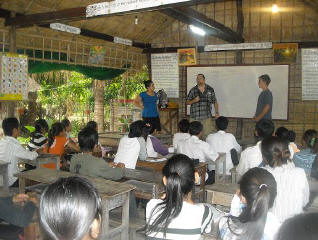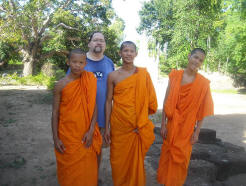Stephanie Long
(8/21) When Emmitsburg commissioner Glen
Blanchard visited Cambodia in July for nearly a month, he experienced a
different culture and things that changed his life. One experience in
particular stands out his mind.
“I never realized before how much I wanted
to practice my own faith,” said Blanchard, who is Catholic. During his trip,
Blanchard stayed at the Buddhist monastery Wat Damnak for four days and lived
as a Monk, participating in daily prayers and meditations with the monks. And
while Blanchard enjoyed the time he spent with the monks, he missed attending
his own church. When he had the opportunity to attend a service at a Jesuit
church, he came to a realization of how much he cherished his faith.
 Blanchard said the service was like the
ones he’s attended in America, but the mix of Eastern culture and Western
religion was prevalent in the church. As everywhere in Cambodia, attendees left
their shoes at the door and the statue of the Blessed Virgin Mary was dressed
in traditional Cambodian clothing. The service was not presented in English,
but Blanchard said it made no difference and the experience was a fascinating
and touching one.
Blanchard said the service was like the
ones he’s attended in America, but the mix of Eastern culture and Western
religion was prevalent in the church. As everywhere in Cambodia, attendees left
their shoes at the door and the statue of the Blessed Virgin Mary was dressed
in traditional Cambodian clothing. The service was not presented in English,
but Blanchard said it made no difference and the experience was a fascinating
and touching one.
Learning and teaching
A year ago Blanchard, who is a history teacher, spent some time in Hawaii
studying Pearl Harbor. While there, he learned of the East-West Center, whose
mission is to help educate and create a dialogue between the Asia Pacific
region and the United States. Through the Center, Blanchard took the
opportunity as a teacher to immerse himself in Cambodia’s culture and history
in Cambodia.
The Emmitsburg Lions Club, Sons of the
American Legion and American Legion all provided sponsorships for Blanchard,
which enabled him to make the trip. He traveled with other teachers, both
current and retired, and experienced all that he could. He even had the
opportunity to each an English class to children in a jungle village.
“It was something I always wanted to do,”
Blanchard said, who at one time wanted to join the Peace Corp and teach
English. “It was a great experience.”
The school was an open-air mud hut in the
jungle, with lizards crawling across the white board as he wrote and rain
pouring down created a different classroom experience.
 “The kids’ enthusiasm to learn English was
inspiring,” Blanchard said. “They know the ability to speak English can bring
them success and that’s very heartening to me.”
“The kids’ enthusiasm to learn English was
inspiring,” Blanchard said. “They know the ability to speak English can bring
them success and that’s very heartening to me.”
Blanchard stayed part of the time with a
host family, the family of Dr. Prak Vonn, in Kampong, Chhnang. Before leaving
for Cambodia, Emmitsburg mayor James Hoover gave Blanchard a key to the city
and asked him to present it to someone worthy while in Cambodia. And after a
few days of staying with Vonn, Blanchard knew Vonn was the perfect recipient.
Blanchard said he was impressed with Vonns’
service to his community, as the local doctor he was willing to see anyone who
came to him for help, and his kind and welcoming heart.
Blanchard also visited many different
historical sites and museums and “impressive and beautiful” temples, but a
visit to one of Cambodia’s most-notorious former prisons and killing fields
changed Blanchard forever.
Seeing it first hand
The notorious rule of Pol Pot in 1970s Cambodia brought about thousands of
executions and murders, and the Khmer Rouge security prison known as S-21 was
the site of thousands of those crimes. Blanchard went on a tour of the prison,
which has now been turned into a genocide museum. His tour guide was Vann Nath,
one of only seven people who survived imprisonment at S-21 by claiming to be a
painter.
As Blanchard walked around the prison,
which prior to Pot’s reign had been a high school, and listened to Nath explain
the atrocities that occurred there, he was struck with an overwhelming feeling
of horror and emotional numbness. Thousands of photographs of genocide victims
cover the walls, skulls are stacked in one room of the prison and paintings
created by Nath depicting the atrocities that happened there hang on the walls.
|

Blanchard presents Dr. Prak Vonn
with a key to
Emmitsburg during Blanchard's trip to Cambodia.
|
“It’s a horrifying place,” Blanchard said.
“You enter and no one says anything. Being a father, with two children, it’s
unspeakably horrifying.”
After S-21, the group visited a “killing
field” where thousands were killed and buried during Pot’s reign.
“There’s an eerie feeling there,”
Blanchard said. “You see the skulls and what it represents in humanity.”
But that “horrifying” experience is one
Blanchard said was necessary for him in truly understand Cambodia’s history.
He hopes to take that experience and bring
it into the classroom in a way that teaches and has a real effect on his
students.
“I hope the photographs help explain it.
The kids (students) understand Darfur, etc., but I can show them examples of
what happened when no one stopped it,” Blanchard said. “It will make it more
real for the kids.”
A spirit about them
But in the face of such a recent bloody past, Blanchard said he saw a spirit in
the people of Cambodia that is striking.
“The past was the war, now it’s
different,” Blanchard said. “The young people see opportunity and there’s a
real sense of optimism in their community. They know how horrific the past was
and they’re incredibly hardworking.”
Blanchard hopes to travel to China or
North Korea next year with East-West Center and encourages anyone “to travel if
you have a chance and to not be afraid of something different.”
He said traveling has had a huge effect on
him and he knows that it would on his students as well.
PHOTOCAPTIONS:
Top: Glenn Blanchard teaches student in a
jungle village in Cambodia. Middle: Blanchard stand with two Buddhist monks at
the Wat Damnak monastery in Cambodia. Bottom:
Read other news stories related to the Emmitsburg Town
Government